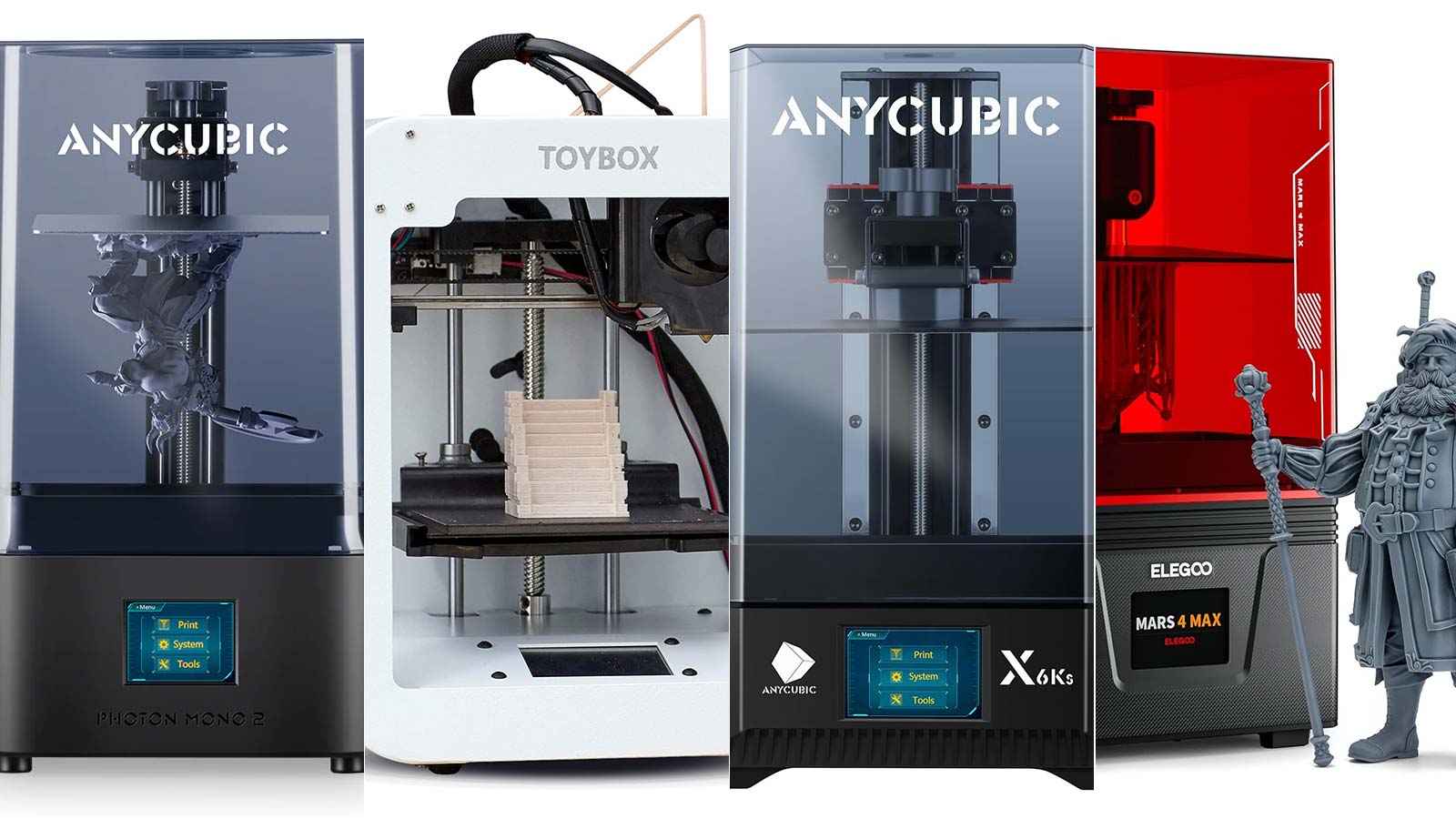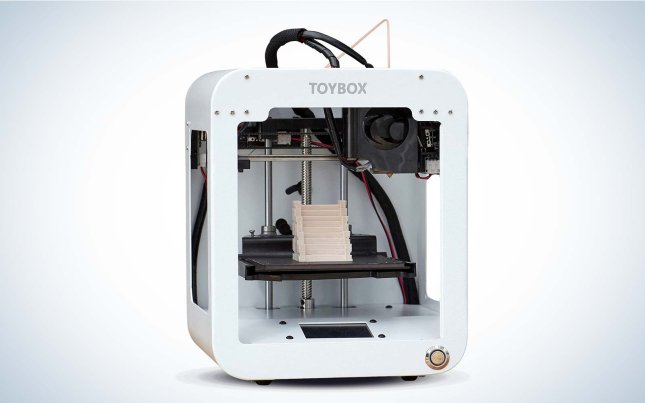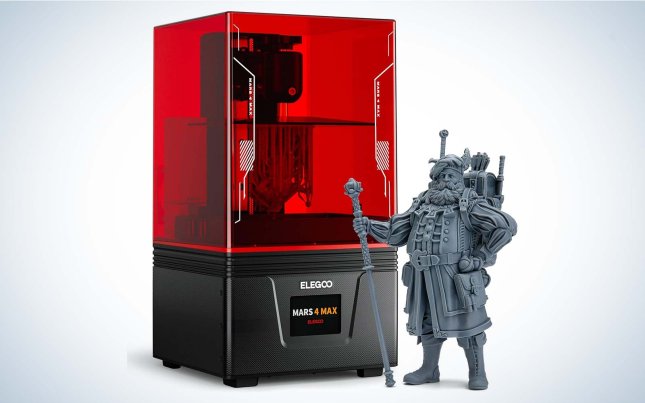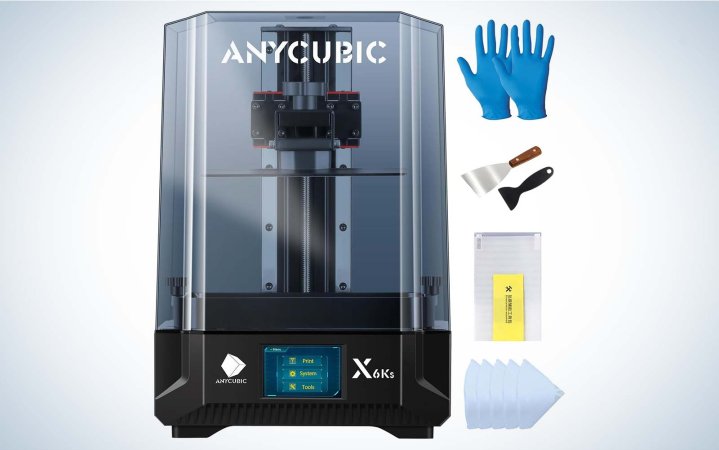We may earn revenue from the products available on this page and participate in affiliate programs. Learn more ›

Whether you want to play an established wargame, roleplay your own scenarios, or make replacement meeples for your favorite board game, you likely want a 3D printer for miniatures. Instead of being focused on large-scale print areas, miniatures lovers want 3D printers that can get heavy detail even when the print outcome is small. But should you go for FDM or resin? Is the 3D printer going to be too complicated? The questions go on and on. Depending on your desires, you might want to make different choices. No matter what, though, we have the perfect suggestions for the best 3D printers for miniatures across the board.
- Best overall: Anycubic Photon Mono X 6Ks
- Best for large armies: Elegoo Mars 4 Max
- Best for terrain: Bambu Lab P1P
- Best for kids: Toybox 3D Printer
- Best budget: Anycubic Photon Mono 2
How we chose the best 3D printers for miniatures
Everyone games differently, so we designed this list to cover a wide area. While many such lists are (rightfully) filled with resin printers only, we found this approach to be too narrow for the typical reader. Our top model will print models with intricate details from resin, but, simply put, not everyone is ready for a resin 3D printer. Having alternatives that are suitable for people of all skill levels, including children, felt more plausible. We also wished to highlight other hobby aspects and find suitable choices for those with alternative needs. Our selections are based on a combination of editorial reviews, hands-on experience, spec comparisons, user reviews, and brand reputation.
The best 3D printers for miniatures: Reviews & Recommendations
Whether you’re into casual accessories or competitive cosplay, 3D printers can be an invaluable accessory. And one of the premier pieces of excitement for commercial at-home 3D printer usage is the ability to make figurines, models, and minis of your choice. We highly encourage this excitement with the following list of 3D printers for miniatures, with options available for those of all ages and experience levels. Here are some options ideal for your next session.
Best overall: Anycubic Photon Mono X 6Ks
Anycubic Photon Mono X 6Ks
Why it made the cut: The Anycubic will satisfy your desire for intense detail.
Specs
- Type: Resin
- Filament supported: (Resin)
- Size: 13.77 x 21.25 x 13.33 inches
- Print area: 195 x 122 x 200mm
- Resolution: 6K (5760 x 3600)
Pros
- Intense resolution for superior model details
- Nearly imperceptible layers
- Good price-to-quality ratio
- Excellent for large “hero” models
Cons
- Not good for beginners
If you’re looking for one of the best quality resin printers to max out the style of your army or D&D player character stand-in, try out the Anycubic Photon Mono X 6Ks. It’s a highly-detailed cousin of the Anycubic Photon 3D printers that you’ll see throughout our listing of the best resin 3D printers, a category of 3D printing that is known for its ability to produce intricate figurines. Much like its relatives that live on that list, Anycubic’s Photon Mono X 6Ks provides great value for the cost and a beautiful touchscreen display.
Its 6K resolution provides miniatures that look fluid and organic in construction, less than layered constructs. While its tall build area won’t necessarily be useful if you’re printing out a Napoleonic regiment, it will serve you well in your plights to make a towering, angry ogre or a stand-in for your player character.
Ultimately, the only thing that isn’t “good” about the Anycubic Photon Mono X 6Ks is its lack of accessibility for beginners. In fact, this isn’t a slight against it. Using a resin-based 3D printer is no easy feat; at 6K, this one is expected to be more advanced than its peers. By the time you’re ready for it, you’re expected to be an established 3D printer with a proper room layout for this machine. If that doesn’t feel like you, we’ve got items that will be more your size later on this list.
Best for large armies: Elegoo Mars 4 Max
Elegoo Mars 4 Max
Why it made the cut: Get the horde of your dreams in a weekend or two with Elegoo.
Specs
- Type: Resin
- Filament supported: (Resin)
- Size: 9.69 x 9.06 x 17.83 inches
- Print area: 195.84 × 122.4 × 150 mm
- Resolution: 6K (5760 x 3600)
Pros
- Prints up to 70mm per hour
- Decent build area
- Supportive community
- Educational videos available
Cons
- Instructional manual can be confusing
Printing models one at a time is okay, but you can also get small platoons out of a printer if you try hard enough. You’ll likely enjoy the Elegoo Mars Max 4’s build area, which can support multiple entities and print speed up to 70mm per hour. Want to get started with a war game in just a weekend? Watch this man’s massive army creation in a weekend tutorial, based on a pair of the older Elegoo Mars 2. Imitate it with the modern Elegoo Mars Max 4 and confer with the community about further ideas to make your print one of the best around.
Such is the way with the Elegoo community. Internally, there is a tendency to admit the instruction manuals tend towards the arcane side at parts, but many are active to help you get over the humps, including on the Elegoo subreddit. The company has also released comprehensive online tutorials to smooth the learning process. In other words, if you have trouble, someone has your back.
Best for terrain: Bambu Lab P1P
Bambu Lab P1P
Why it made the cut: A huge print area and fast printing speed means you can move mountains (to the table) easily!
Specs
- Type: FDM
- Filament supported: PLA, ABS, PETG, etc.
- Size: 15.2 x 15.3 x 18 inches
- Print area: 10 x 10 x 10 inches
- Resolution: N/A
Pros
- Incredibly fast running
- Multi-color printing options available
- Large build area
- Beginner approved
Cons
- Low resolution
If you already have an officially sanctioned army of store-bought figurines, you might’ve found that you wanted to populate your battlefield with campaign-specific terrain. Or perhaps a spiral staircase ornament makes the perfect dungeon prop. And who can forget the hedgerows of Normandy?
To make these battlefield and roleplay essentials, the Bambu Lab P1P is probably your best bet. It has a large print area, and it gets the job done fast, with mountains and hedgerows being printed at a standard rate of 500 mm/s. Despite the speed, the print plate’s vibration compensation also ensures you’ll get a good, non-wobbly product (including on the critical first layer).
The best part is that you won’t have to do too much to get all these results, either. Once set up, it’s ready to go. This quick setup and go is one of the main reasons the Bambu Labs P1P is also featured as one of the best 3D printers for beginners.
This isn’t to say, however, that the printer can’t get more complex as you grow into it. There are options for adding multiple colors to the printing and an attachable time-lapse camera. Really, the only thing not perfect about this printer is the FDM-tier resolution, but that shouldn’t get in the way of you enjoying yourself, especially for terrain.
Best for kids: Toybox 3D Printer
Toybox 3D Printer
Why it made the cut: It may not pull the same level of detail as a resin printer, but even children can operate it.
Specs
- Type: FDM
- Filament supported: PLA
- Size: 7.4 x 7.4 x 9.05 inches
- Print area: 7 x 8 x 9 cm
- Resolution: 200 microns
Pros
- Child friendly
- Ready to use in minutes
- Online catalog with miniatures
Cons
- Low resolution
The Toybox 3D Printer is a simple-to-use 3D printer that can be set up in less than an hour by just about anybody, including first-time users. When connected via WiFi to your phone and computer, you can select from 100s of models to print, no sizing or editing required. As long as children know not to touch the (very) hot filament extruder, they should be able to operate the machine 90 percent on their own, with responsible pre-teens needing next to no supervision. However, don’t let age scare you away, as people of all ages can enjoy this 3D printer.
Searching for ‘miniatures’ on the Toybox website reveals a set of “DnD Miniatures” as well as things like a goblin assassin, orc smasher, and other generic fantasy creatures. If that’s not enough, you can even import models from special files, though this is an admittedly advanced feature.
One thing that our Toybox 3D Printer review pointed out that is quite relevant here is how much stuff you can get out of the filament provided. Even though additional filament from Toybox remains cheap, expect to get well over a dozen prints from what you originally sent before considering buying more.
Best budget: Anycubic Photon Mono 2
Anycubic Photon Mono 2
Why it made the cut: You don’t have to spend an arm and a leg for a resin printer.
Specs
- Type: Resin
- Filament supported: (Resin)
- Size: 15.4 x 9.01 x 9.25 inches
- Print area: 6.5 x 3.5 x 5.6 inches
- Resolution: 4K
Pros
- 4K resolution on the cheap
- No grid lines
- Includes gloves, funnel, spatula, and other necessary tools
Cons
- Requires manual leveling
Looking at the quality and intensity of resin 3D printers today, it can seem like you would always have to shell out hundreds of dollars to acquire one. The Anycubic Photon Mono 2, however, is here to prove that sentiment wrong, providing 4K printing with no grid lines under $250.
To add even more bang for your buck, the kit includes other essentials like gloves, a funnel, leveling paper, a screen protector kit, and a pair of spatulas. You’ll even get a USB drive to keep your print files (or whatever else you want) on. The main thing that is missing is an automatic leveler, but manual leveling is worth taking the time to figure out in exchange for a printer of this price.
What to consider before buying 3D printers for miniatures
The fact of the matter is getting the best 3D printers for miniatures depends on a lot of factors, including the aims of your gaming, what kind of miniatures you want to print, and how picky you are about appearances. And that’s all before we consider budget. While we can recommend an overall best that will suit the needs of the largest number of typical customers, the reality is no one printer will be the best for everyone in this category.
Here, we will go through a number of choices and decisions you will have to make on your purchasing journey, highlighting what will be best for each type of miniature printer consumer.
Resolution vs. size
Typically, when we discuss 3D printers, especially for general audiences, the print’s size will be emphasized. This statistic, also known as its “build area” or “print area,” makes sense to focus on for most people. Bigger equals more.
However, in the world of 3D printers for miniatures, the printer’s resolution plays a more important role. Small, defined placement of FDM or controller light exposure (resin printers tend to have better resolution) can create models with incredible smoothness that look beautiful and organic. They’re a far cry from layered creations. The printers that aren’t of the super highest resolution on this list aren’t producing blocky constructs, to be clear, but the difference is noticeable.
Note that size can still be an important factor in miniatures, especially if you want to print large terrain features or sets of armies in a single batch. Also, note that decent resolution and print area are not mutually exclusive properties; you can get both. But if cost is a limiting factor, you should nearly always go with the highest resolution 3D printer for miniatures available, even if you have to sacrifice a bit of print area to get it.
Resin vs. FDM
So, we’ve established resolution rules when it comes to selecting the best 3D printers for miniatures. We’ve also touched on the point that, in general, resin 3D printers reign supreme in the resolution department. In fact, many websites will only recommend resin printers when choosing the best 3D printers for minis.
We’ve decided to go a different route and believe the choice isn’t as cut and dried as others make it out to be.
The reason is that resin 3D printers are more involved and can be dangerous if you aren’t willing to take your time and do things properly. Curing is involved, you need gloves, and the resin itself is toxic.
For a casual printer looking for reasonably good models, an FDM printer is best. And, to be clear, you can get perfectly good-looking models from FDM printers, no doubt about it.
On the other hand, expert printers and those looking for an involved hobby should choose resin printers, as they will ultimately produce the best product.
Print speed
If your goal is to print out a single miniature to represent your DnD character, print speed largely doesn’t matter. Just start the printing up and come back later. No problem.
Similarly, if you’re fine with reusing the same miniatures again and again, speed won’t be too much of an issue. Those bayonet-wielding Napoleonic musketmen are basically orc chainsaw gunmen, right?
But, if you want a new large army for each game, batches start to become important. As we previously mentioned, size can mitigate this to some degree, but if you’re a serial printer, time will eventually add up to something big.
For FDM printers, expect between 20mm and 70mm per second. The higher that number is, the faster it’ll print. Resin printers print entire layers at a time, so they’re faster for creating multiple minis at the same time.
FAQs
Typically, a 3D printer for miniatures will cost at least $300. Anything more than that shouldn’t come as a shock, either. If you can find one for under $300, such as with the Anycubic Photon Mono 2, be sure to look at the drawbacks (in this case, no automatic leveling) and make sure you can handle them.
When it comes to making miniatures, the disadvantage of FDM printing is lower resolution. However, we don’t believe that should discourage you, as a good paint job and a bit of imagination will go a long way. While we do acknowledge that the very best 3D printers for miniatures are resin printers, not everyone can be expected to use them effectively. As a result, depending on your level of commitment to the hobby, the disadvantages of an FDM printer can easily be overcome.
First and foremost: We are not lawyers, and if you really want to know if your actions are legal, you should consult an actual lawyer. This advice is only for informational purposes. The laws and regulations may differ in your state, country, or region. In general, it should be legal to sell 3D-printed miniatures as long as you own the IP rights to what is printed.
Final thoughts on the best 3D printers for miniatures
- Best overall: Anycubic Photon Mono X 6Ks
- Best for large armies: Elegoo Mars 4 Max
- Best for terrain: Bambu Lab P1P
- Best for kids: Toybox 3D Printer
- Best budget: Anycubic Photon Mono 2
Getting started using a 3D printer for your miniatures hobby does not need to be a difficult task. Whether you want to go for a complex machine that can build detailed 8K 3D sculptures or a simple FDM printer that makes quality miniatures anyone can produce, you can find it on the preceding list.







